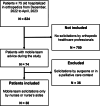Empowering orthopedic nurses' and nurse's aides through a multimodal geriatric mobile team: a mixed methods study
- PMID: 40597272
- PMCID: PMC12210491
- DOI: 10.1186/s12912-025-03410-4
Empowering orthopedic nurses' and nurse's aides through a multimodal geriatric mobile team: a mixed methods study
Abstract
Background: Despite their proven effectiveness, geriatric perioperative units face organizational constraints that limit access to care. A mobile geriatric team can extend expertise to orthopedic wards, assessing older patients at nurses' and nurse's aides' request. This study explored caregivers' perceptions of the geriatric mobile team and examines the quality of patient care before and after its intervention.
Methods: This mixed-methods study used a convergent design. The mobile team provided direct geriatric expertise at the request of orthopedic caregivers and implemented an educational program to enhance their skills in caring for older adults. Training included "aging simulation" workshops, error-awareness exercises ("room of errors" workshops), and courses on hospital-associated disability. Quantitative evaluation focused on post-operative care in four key areas: pain management, mobilization, nutritional screening, and continence care, along with adherence to the mobile team's recommendations. Qualitative analysis involved focus groups with nurses and nurse's aides to capture their experiences and perspectives.
Results: Between December 2022 and April 2023, 38 patients were evaluated by the mobile team (mean age: 84 years ± 6.1; 42% male). Patients were relatively independent (median ADL score: 6 [6-6]), with 24% experiencing neurocognitive disorders. The mobile team improved care appropriateness in over 70% of cases across all four domains. Nurses and nurse's aides reported that the mobile team alleviated their feelings of isolation and lack of recognition by fostering horizontal communication and shared decision-making, reinforcing their role in patient-centered care.
Conclusion: In orthopedic settings, a perioperative geriatric mobile team plays a critical role in supporting nurses as clinical care partners and nurse's aides as frontline caregivers. By providing both hands-on assistance and targeted education, the team strengthens geriatric-centered care beyond specialized geriatric units, enhancing both professional confidence and patient outcomes.
Clinical trial number: Not applicable.
Keywords: Geriatric mobile team; Interdisciplinary collaboration; Orthogeriatrics; Patient safety; Simulation-based training.
© 2025. The Author(s).
Conflict of interest statement
Declarations. Ethics approval and consent to participate: In May 2023, this study received approval from the “Gerontopole d’Ile-de-France” (GEROND’IF, https://www.gerondif.org/equipe-expertise ) Ethics Committee in Paris (approval no. 42023), confirming its adherence to MR-004 criteria established by the French Data Protection Authority (CNIL). The non-opposition of patients and healthcare professionals was obtained prior to the collection of their data (quantitative and qualitative, respectively). We declared that research is in compliance with the Helsinki Declaration ( https://www.wma.net/policies-post/wma-declaration-of-helsinki/ ). Patients provided written consent to participate before each geriatric assessment conducted by the geriatric mobile team. Similarly, nurses and nurse’s aides gave their written consent before the focus groups were conducted and recorded. In both cases, consent was obtained following a process of free and informed information. Consent for publication: The only images in the manuscript are found in the Supplemental Materials (Supplemental S2: “Aging simulation” workshop program and details) and do not depict participants of this study. This picture comes directly from the simulation costume website: https://www.simulateur-du-vieillissement.com/notre-original.html?%20gad_source=1&gclid=CjwKCAjwqi_BhBxEiwAkxvbkPfK2OKVyeFviPjePo5Xaczj3PY0CqGBtBkjSWcohswXmRIZd08eIRoCfMEQAvD_BwE . There are no other personal or clinical details of participants that compromise anonymity. Competing interests: The authors declare no competing interests.
Figures



References
-
- Johnell O, Kanis JA. An estimate of the worldwide prevalence and disability associated with osteoporotic fractures. Osteoporos Int. 2006;17(12):1726–33. - PubMed
-
- McIsaac DI, Beaulé PE, Bryson GL, Van Walraven C. The impact of frailty on outcomes and healthcare resource usage after total joint arthroplasty: a population-based cohort study. Bone Joint J. 2016;98–B(6):799–805. - PubMed
LinkOut - more resources
Full Text Sources
Miscellaneous

